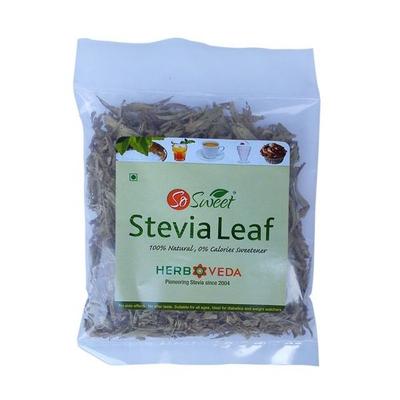

Netmeds First Membership
Description
Stevia’s excellent stability against pH, salt, or high-temperature conditions makes it an ideal sugar substitute for many baking and cooking applications. Stevia by and large is compatible with salts, organic acids and other natural sweeteners without fermenting and precipitating.
Stevia’s excellent stability against pH, salt, or high-temperature conditions makes it an ideal sugar substitute for many baking and cooking applications. Stevia by and large is compatible with sal...
Key Benefits
While Stevia is very popular as a natural sweetener, few people would know of its miraculous healing properties in the treatment and control of a host of common diseases. It is especially useful in the treatment and management of diabetes and hypertension (blood pressure) and is well known as a plaque retardant.
- Preventive Control for Diabetes
- Improving Tooth Care
- Reducing Hypertension
- Universal Tonic
- As a Digestive Supplement
- For Skin Care
- For Reducing Weight
- Stevia- Controlling Addictions
- Stevia’s antimicrobial Property
- Probable Cardio Tonic
While Stevia is very popular as a natural sweetener, few people would know of its miraculous healing properties in the treatment and control of a host of common diseases. It is especially useful in...
Direction for Use/Dosage
In December 2008, the US Food and Drug Administration (FDA) approved the use of high-quality Stevia extract in food and beverages. This positive movement resulted in the removal of restrictions on the use of Stevia as an ingredient in many countries and is widely accepted to be consumed as a dietary supplement. Here is a list of some of the applications for which Stevia is suitable:
- Soft drinks, fruit juices
- Tabletop sweetener for tea, coffee and beverages
- Ice cream, yogurts, sherbets
- Pastries, pies, baking
- Jams, sauces, pickles
- Jellies and deserts
- Chewing gum
- Candies and confectioneries
- Seafood and vegetables
- Weight-watchers diets
- Diabetic diet
- Alcoholic beverage
In December 2008, the US Food and Drug Administration (FDA) approved the use of high-quality Stevia extract in food and beverages. This positive movement resulted in the removal of restrictions on ...
Safety Information/Precaution
To be used as directed by the physician.
Other Information
First officially discovered in the 19th century by Dr. Moises Santiago Bertoni, the Stevia plant is a part of the Chrysanthemum plant species and is related to Lettuce, Marigold and Chicory as well. Christened Stevia Rebuadiani Bertoni in honor of the eminent Paraguayan Chemist, Rebaudi, the leaves of Stevia was used by Guarani Indians for sweetening the tea as well as making sweet treats.
Initially found in the lush forests of the Amabai Mountains in the Cordilleras Range in the northern part of South America besides the Brazil-Paraguay border, Stevia has seen a tremendous spurt in growth. The incredible healing properties of this naturally occurring sweetener stimulated the cultivation of Stevia in various parts of the world.
First officially discovered in the 19th century by Dr. Moises Santiago Bertoni, the Stevia plant is a part of the Chrysanthemum plant species and is related to Lettuce, Marigold and Chicory as well...






